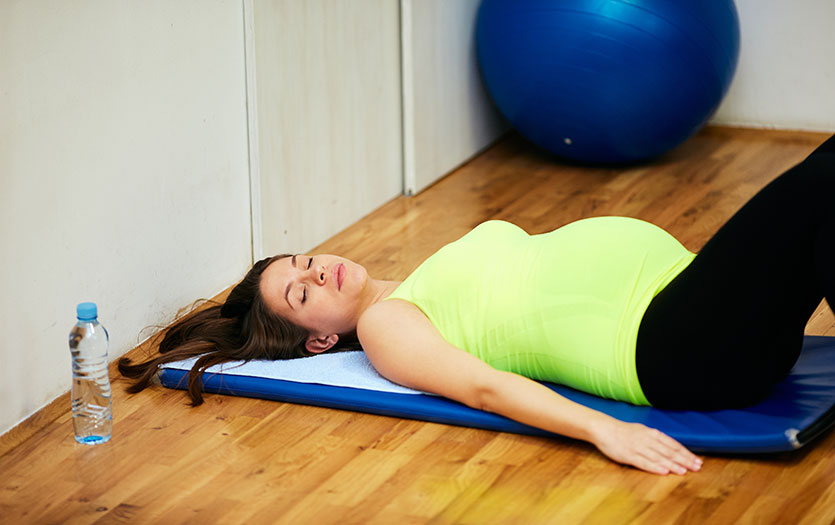Think of your body as a well-oiled machine. Every part plays a role, including those unseen muscles we often overlook. Among those are your pelvic floor muscles, a crucial group that supports various organs, including the bladder, uterus, and bowels. These muscles are also key players in promoting sexual health and function.
However, like any other muscle, the pelvic floor can weaken over time or due to specific events like pregnancy, childbirth, or surgery. Weak pelvic floor muscles can lead to issues such as urinary incontinence and pelvic organ prolapse. But don’t fret! There’s a simple solution: Kegel exercises. Designed to keep your pelvic floor fit and strong, they’re the secret weapon you didn’t know you needed. Stay tuned as we guide you through these exercises, enhancing your overall health and well-being.

Contents
- 1 How To Exercise Your Pelvic Floor For Better Health?
- 1.1 1. Identify Your Pelvic Floor Muscles:
- 1.2 2. Perfect the Technique:
- 1.3 3. Maintain Your Focus:
- 1.4 4. Gradually Increase the Intensity:
- 1.5 5. Incorporate into Daily Routine:
- 1.6 6. Advanced Techniques:
- 1.7 7. Monitor Your Progress:
- 1.8 8. Maintain Regular Practice:
- 1.9 1. Improved Bladder and Bowel Control:
- 1.10 2. Prevention and Management of Prolapse:
- 1.11 3. Enhanced Recovery Postpartum:
- 1.12 4. Improved Sexual Function:
- 1.13 5. Support for Pelvic Surgery:
- 1.14 6. Increased Stability and Core Strength:
- 1.15 7. Improved Pelvic Health During Menopause:
- 1.16 8. Psychological Benefits:
- 2 Frequently Asked Questions
How To Exercise Your Pelvic Floor For Better Health?
Exercising your pelvic floor muscles is crucial for both men and women as it supports bladder control, and bowel function, and can improve sexual health. Strengthening these muscles is especially beneficial during pregnancy, after childbirth, and as you age. Here’s a step-by-step guide on how to exercise your pelvic floor muscles effectively for better health:
1. Identify Your Pelvic Floor Muscles:
The first step is identifying the correct muscles to target. These are the muscles you use to stop urinating mid-stream or to hold in gas. You can practice stopping and starting your urine flow to get a feel for these muscles, but it’s not recommended to do this regularly as it can be harmful to bladder health.
2. Perfect the Technique:
Once you’ve identified the pelvic floor muscles, empty your bladder and lie down or sit comfortably. Tighten your pelvic floor muscles, hold the contraction for five seconds, and then relax for five seconds. Try to focus solely on tightening the pelvic floor muscles and avoid tensing the muscles of the abdomen, thighs, or buttocks.
3. Maintain Your Focus:
It’s important to breathe freely during the exercises; don’t hold your breath. Some people find it easier to perform these exercises lying down initially, as less pressure is placed on the pelvic floor and it’s easier to feel the contractions.
4. Gradually Increase the Intensity:
As you get used to the exercises, aim to hold each contraction for 10 seconds followed by a 10-second relaxation. Increase your repetitions gradually; start with 10 repetitions per session and try to work up to three sets of 10 repetitions each day.

5. Incorporate into Daily Routine:
Make pelvic floor exercises a part of your daily routine. You can perform them during mundane activities like brushing your teeth, sitting at your desk, or while watching TV. Consistency is key to seeing benefits.
6. Advanced Techniques:
Once basic pelvic floor exercises become easier, you can move on to more challenging exercises such as bridge poses or incorporate tools like Kegel weights or vaginal cones. Yoga and Pilates are also great for strengthening the pelvic floor along with other core muscles.
7. Monitor Your Progress:
You might start to notice improvements, such as fewer instances of urinary leakage, within a few weeks to a few months. If you don’t notice improvement, it might be helpful to consult with a healthcare provider or a specialist like a pelvic floor physical therapist. They can provide guidance and help ensure you are performing the exercises correctly.
8. Maintain Regular Practice:
Even after symptoms improve, continue doing pelvic floor exercises to maintain muscle tone. As with any muscle group, regular maintenance is necessary for long-term benefits.
Benefits of Pelvic Floor Exercises
Pelvic floor exercises, also known as Kegel exercises, offer a range of benefits for both men and women, impacting various aspects of health and well-being. Regularly performing these exercises can significantly enhance pelvic health and prevent issues that may arise due to a weakened pelvic floor. Here are some of the key benefits:

1. Improved Bladder and Bowel Control:
Pelvic floor exercises strengthen the muscles that support the bladder and bowel, which can help reduce symptoms of urinary and fecal incontinence. This is particularly beneficial for women post-pregnancy and men post-prostate surgery, both of whom may experience weakened pelvic muscles that can lead to incontinence.
2. Prevention and Management of Prolapse:
In women, a strong pelvic floor can help prevent the descent of pelvic organs into the vaginal canal, known as prolapse. For those who already have some degree of prolapse, pelvic floor exercises may help manage the symptoms and prevent further descent.
3. Enhanced Recovery Postpartum:
After childbirth, the pelvic floor muscles can be stretched and weakened. Regular pelvic floor exercises help restore muscle tone and strength, aiding in faster recovery from childbirth. They can also help reduce the risk of incontinence after pregnancy.
4. Improved Sexual Function:
Strong pelvic muscles can enhance sexual sensation and increase the ability to achieve pleasurable muscle contractions during sexual activity. For men, pelvic floor exercises can improve erectile function and ejaculatory control. For women, these exercises can lead to enhanced sensitivity during sex and more intense orgasms.
5. Support for Pelvic Surgery:
Pelvic floor exercises can improve outcomes for individuals undergoing pelvic surgery by strengthening the muscles and improving blood flow to the area. This can aid in quicker recovery and reduce the likelihood of postoperative complications related to incontinence and prolapse.
6. Increased Stability and Core Strength:
The pelvic floor muscles are part of the body’s core stabilizing system, which includes the abdominal and back muscles. Strengthening these muscles can improve overall stability and balance, which is beneficial for general fitness and may help prevent falls in older adults.

7. Improved Pelvic Health During Menopause:
During menopause, decreased estrogen levels can affect the strength and elasticity of the pelvic floor muscles. Engaging in regular pelvic floor exercises can help counteract these effects, maintaining pelvic health and function.
8. Psychological Benefits:
Dealing with incontinence or pelvic organ prolapse can be stressful and may impact a person’s quality of life. By improving control and alleviating symptoms, pelvic floor exercises can boost confidence and reduce stress and anxiety related to pelvic health issues.
Frequently Asked Questions
Can individuals feel when you do a Kegel exercise?
Absolutely, it’s possible for individuals to feel the tightening when a person, most notably in women, contracts the pelvic floor muscles during Kegel exercises.
How can I detect signs of a strengthening pelvic floor?
Improvements indicative of a strengthening pelvic floor include experiencing fewer urinary or bowel “accidents,” reduced feelings of urgency to use the restroom, greater control over bladder and bowel movements, and the ability to perform Kegel exercises with ease.
What are the symptoms of a weak pelvic floor?
Signs of a weak pelvic floor may include urine leakage during physical exertion such as coughing, sneezing, laughing, or running, inability to reach a restroom in time, unintentional passing of wind from the anus or vagina during lifting or bending, reduced vaginal sensation, dislodgement or falling out of tampons, and a visible bulge at the vaginal opening.
Does walking help alleviate a tight pelvic floor?
Yes, walking can contribute to alleviating pelvic floor tightness. However, it’s most effective when combined with other therapies such as pelvic floor exercises, yoga, pilates, and targeted stretching.
Do squats contribute to strengthening the pelvic floor?
Yes, squats are beneficial for promoting a stronger pelvic floor and buttocks. They involve standing with feet hip-width apart, bending at the knees and lowering the buttocks toward the floor while keeping the back straight and leaning slightly forward.

Hello, I’m Ravindra. Over the years, I’ve immersed myself deeply into the world of fitness and health, transforming both my body and mind. Writing has allowed me to share my journey, insights, and expertise with those just starting out and seasoned fitness enthusiasts alike. Beyond just routines and diets, I believe in inspiring others to adopt a holistic approach to well-being.
